Horrors of Vietnam War – 100 Pictures
Cover Photo: Battle of Saigon, the First Offensive, on February 10, 1968.
Photo: Eddie Adams/AP
The article is in draft form, and incomplete.
(ফাইন্যাল হয়ে গেলে এখানে থাকবে সোহম দাশগুপ্তের একটি কবিতা)
There is a saying “…. The people of Germany and Japan had to rebuild their nation, as they surrendered after the shameful end of the second World War in 1945. In Vietnam too, people had to rebuild their nation, though devastated but not as a consequence of loss, rather that of a glorious victory against the mighty United States of America in 1975.
America has always regarded Vietnam War as its own personal horror story. Illustrated in presidential speeches, from President Jimmy Carter to President Barack Obama. Carter described Vietnam War as one “of mutual destruction.” While no one denies the tragedy of the 58,000 American dead, that figure pales next to the 6 million Vietnamese, Laotians and Cambodians who died during the war and its aftermath. Obama’s 2012 speech commemorating the 50th anniversary of the war continued to focus squarely on American soldiers with virtually no mention of Vietnamese fatalities. It also went a step further, explicitly describing the war as one of “noble sacrifice”.
After WW2, this is the only war that lasted for 20 years.
Vietnam fought their battle of independence against France, and got their victory in 1954. Though defeated but France wanted to hold “some power”, and then America landed in the field, and USSR and China carefully watching the situation. The country having no political experience began a civil war. America took control of Southern part, where as communist forces, under Ho Chi Minh took control of the North. American President Dwight D Eisenhower said “… fall of French Indochina to communists could create a “domino” effect in Southeast Asia.” So, on the excuse of Domino Effect, America found an obedient army person Ngo Dinh Diem, and “authorised” him to rule the country, obviously under America’s supervision.
One simple statement would make the horror picture clear, “… The deaths of 3 million Vietnamese and 3 million Cambodians and Laotians during and after the Vietnam War…..”
Let’s talk about just one military campaign, Operation Rolling Thunder.
Between 2 March 1965 until 2 November 1968, it was a gradual and sustained aerial bombardment campaign bu the USA Air Force, USA Navy, with the help of Vietnam Air Force, against North Vietnam, part of China, and North Korea. America’s intention was to ignite another World War, but China and North Korea could defuse the 3rd World War. Between 1965-1975, USA bombed 7.5 million tonnes, the figure is double that of combined bombing on Europe and Asia during WW2. And 8,64,000 tonnes were bombed (Christmas Bomb) only during Operation Rolling Thunder, on Vietnam, Laos and Cambodia. So far, it ranks at number one, in history of aerial bombardment. American President Johnson approved limited bombing on a network of pathways that connected North Vietnam and South Vietnam by way of neighboring Laos and Cambodia. The president’s goal was to disrupt the flow of manpower and supplies from North Vietnam to its Viet Cong allies.
Let me share some of the horror pictures:
To start with
Phu Quoc Prison (Vietnamese: Nhà tù Phú Quốc)
The prison was built in 1949–1950 by French colonialists as a place to detain political dissidents, in an area of 40,000 square meters (0.015 sq. mi) to accommodate 3 thousand prisoners. Between 1967 to 1973, 4,000 prisoners died and thousands became disabled, and then International Committee of Red Cross (ICRC) visited Phu Quoc Prison in 1969 and in 1972. Committee found the prisoners without inadequate food supplies, medical care but signs of brutal tortures.
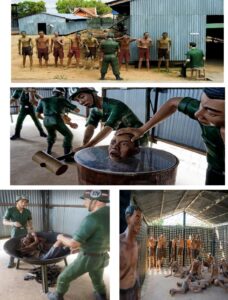
The Phu Quoc prison had a Tiger’s cage, which is 1 by 2 meters covered with barbed wire. In the Tiger’s cage, prisoners could not lie down, stand or sit because if they moved they would be scratched and cut open by barbed wire. When it was hot, prison guards placed a furnace next to the container and when it was cold, the guards poured more water into the container. The prisoners were nailed in ankles, knees, and even the head.
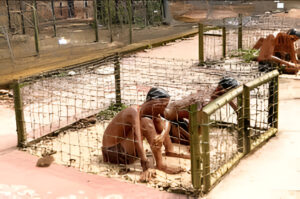
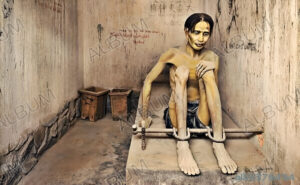
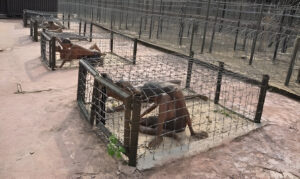
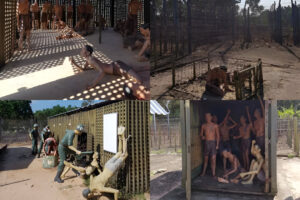
Operation Agent Orange
Agent Orange, in terms of chemistry, “….a chemical herbicide and defoliant used by the U.S. military during the Vietnam War (1961-71). It is a mixture of two herbicides. In addition to its damaging environmental effects, have caused major health problems for many individuals who were exposed, and their offspring. Thousand and thousands of Vietnamese people became permanently disable due to the effect of Agent Orange. In addition, few hundred thousands of agricultural lands were destroyed.
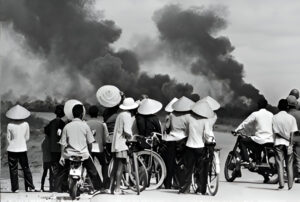
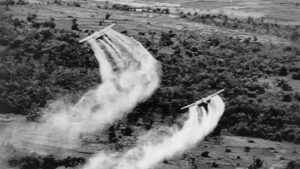
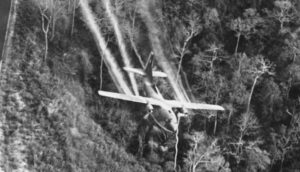
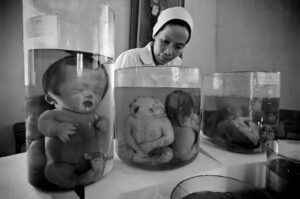
A few Human Fetuses are preserved at the War Museum, Saigon. however destroyed in exposure due to dioxins and dioxin-like compounds, contained in the defoliant Agent Orange.
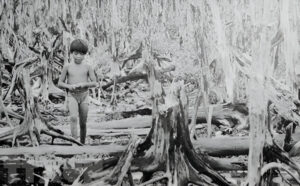
Agent Orange was usually sprayed from helicopters or from low-flying aircraft, fitted with sprayers and “MC-1 Hourglass” pump systems and 1,000 U.S. gal (3,800 L; 830 imp gal) chemical tanks. Altogether, 21,000,000 US gal of Agent Orange were sprayed. The U.S. Air Force records show at least 6,542 spraying missions took place over the course of Operation Ranch Hand. By 1971, 12 percent of the total area of South Vietnam had been sprayed with defoliating chemicals, In South Vietnam alone, an estimated 100,000 km2 of agricultural land was destroyed. 20,000 km2 (7,700 sq. mi) of upland and mangrove forests and thousands of square kilometers of crops were destroyed.
The U.S. military began targeting food crops in October 1962, primarily using Agent Blue, however the American public was not made aware of the crop destruction programs until 1965. In 1965, US Congress members were told, “crop destruction is understood to be the more important purpose … but the emphasis is usually given to the jungle defoliation in public mention of the program.” The first official acknowledgment of the programs came from the State Department in March 1966
Tens of thousands of people died in a painful death and resentment due to incurable diseases. Many female victims have experienced reproductive problems, being deprived of being a mother. The most disastrous is that their offsprings, those who did not take part in the war also become Agent Orange victims with born malformations.

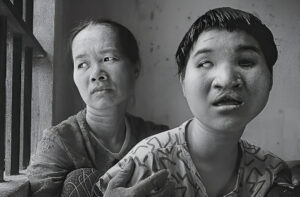
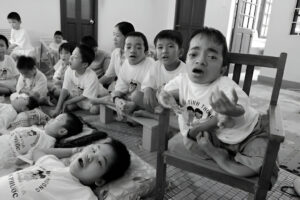
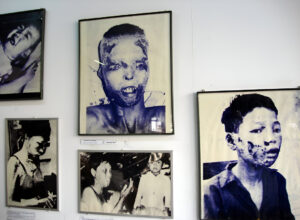
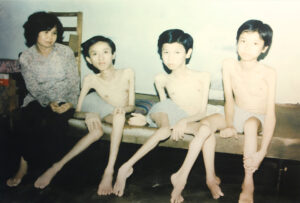
A legal precedent has paved the way for Vietnam to demand Monsanto pay compensation to the many victims of Agent Orange. While previous claims said herbicides produced by Monsanto – and other companies – and used during the war were harmless, the recent verdict refutes those claims. The company, now part of Bayer AG, was ordered to pay $289 million in restitution to Johnson, a former pest control manager for a California country school system, after a jury at San Francisco’s Superior Court in California ruled that Monsanto failed to warn users of it’s product about the health risks. Vietnam is now using this as grounds for Agent Orange victims.
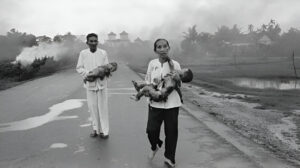
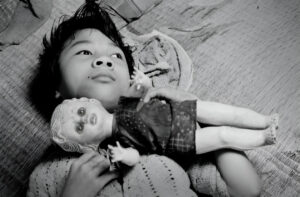
*******
Of the over 200 armed conflicts after the end of World War II, more than 80 percent were initiated by the US. The wars could never bring a “better future,” but instead left behind a heap of mess. the only system that the US could do was to plunge countries into complete chaos. In 1955, the US went from its initial promise of “establishing a democratic regime” to ultimately a shameful tragedy of the “Saigon iron fist”. (“Saigon Iron Fist” is a phrase associated with the brutal suppression of dissent and opposition by the South Vietnamese government, particularly under Ngo Dinh Diem, during the Vietnam War. It refers to the oppressive tactics and policies used to maintain power and suppress any perceived threats to Diem’s rule).
From 1955 till 1975, the US deployed up to over 500,000 troops to Vietnam. As the war progressed, the promises made by the US kept changing, from initially promising to establish a “unified, freely elected democratic regime” in Vietnam to a “stable, free South Vietnam,” to eventually sanctioning a so-called “orderly withdrawal,” which in reality turned into a chaotic farce in the final hours. Finally in April 1975, the People’s Army of Vietnam closed in on Saigon, completely surrounding the city and destroying the airport. In just one day, the US evacuated over 7,000 people using helicopters, an operation called “Frequent Wind.”
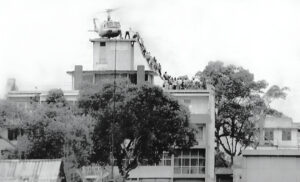 29th April, 1975
29th April, 1975
American, assembled at the roof top of Saigon President’s Palace, being evacuated by American Air Force helicopters.
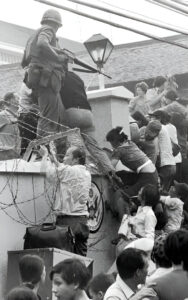 April 29, 1975:
April 29, 1975:
People try to scale the 14-foot wall of the US Embassy in Saigon, trying to reach evacuation helicopters, as the last of the Americans depart from Vietnam.
Credit: AP Photo/Neal Ulevich
According to a report by CBS on April 30, 1975, the evacuation was chaotic for Americans and despairing for the Vietnamese. For the remaining Americans, as long as they were not late, they could catch the departing helicopters. In the vicinity of the US Embassy which served as an evacuation point, however, thousands of Vietnamese nationals attempted to climb over the walls and rush toward the helicopters in vain.
******
Self-immolations by Buddhist monks
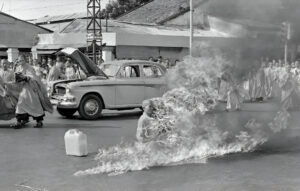 11 June 1963
11 June 1963
In the first of a series of self-immolations by Buddhist monks, Thich Quảng Đức burns himself to death on a Saigon street to protest against the military tortures on their religion and people, and persecution of innocent Buddhists by the South Vietnamese government. The photograph aroused worldwide outrage and hastened the end of the Ngo Dinh Diem government. With the photograph on his Oval Office desk, President Kennedy remarked to his ambassador: “We’re going to have to do something about that regime.”
Photograph: Malcolm Browne/AP
(The 1963 World Press Photo of the Year)
Before closing my eyes to Buddha, I respectfully plead to President Ngo Dinh Diem, asking him to be kind and tolerant toward his people and to enforce a policy of religious equality.
– The last written words of Thich Quang Duc, a Buddhist monk who burned himself to death to protest the regime in South Vietnam, 1963
I was too shocked to cry, too confused to take notes or ask questions, too bewildered to even think.
– New York Times correspondent David Halberstam, a witness to the self-immolation of a Buddhist monk in Saigon, June 1963
No news picture in history has generated so much emotion around the world as that one.
– US President John F. Kennedy
On the morning of June 11, 1963, Photographer Malcolm Browne ran to the Saigon intersection with his Vietnamese colleague.
“We reached an intersection of one of the main streets – Phan Đình Phùng with the cross street. All traffic was blocked in both directions.
Anan old Austin automobile drove up to the center and out stepped an old man, very old monk who, I learned later his name was Thich Quang Duc; and two younger monks. He was resting his hands on their arms and they brought him over to the center of this circle, put down a tan cushion in the middle of the asphalt and – it’s a horrible recollection.
They went back to the car and got out a polyethylene jerry can filled with pink gasoline, which I learned later had been diluted jet aviation fuel to make it burn for a longer time. And they poured it over his head, took a few steps back and at that point he, he pulled out a box of matches and struck one of them and dropped it in his lap and the flames of course engulfed him immediately. And he, his face winced. You could tell from his expression that he was in terrible pain, but he never cried out and he burned for, oh, I suppose 10 minutes or so, or perhaps a bit more. It seemed like an eternity.
Of course it was.”
Brown’s picture moved within the hour. At the White House, President John F. Kennedy saw it in the papers and exclaimed: “Jesus Christ”. He then ordered a review of his administration’s Vietnam policy.
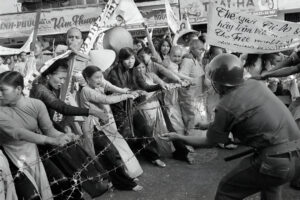 17 July, 1963
17 July, 1963
Buddhist monks and women pull at a barbed-wire barricade that was set up in front of Saigon’s Giac Minh Pagoda to halt a demonstration. Police wielding clubs injured at least 50 people during the protest, one of many during this period by Buddhists opposed to the Diem regime. The following month, secret police raided temples throughout the country, an act that only heightened anger against the government.
Photograph: Horst Faas/AP
*******
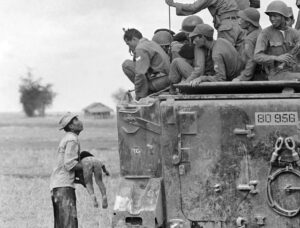 19 March 1964.
19 March 1964.
A distraught father holds the dead body of his child.
The Rangers were in search of few suspected guerrillas but could not find any. They found the boy, killed him and handed over the childs dead body to his father. The armymen look down from their armoured vehicle. The child was killed as government forces pursued guerrillas into a village near the Cambodian border.
AP photographer Horst Faas received the 1965 Pulitzer prize for photography
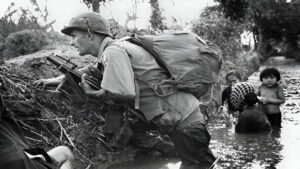 Jan. 1, 1966.
Jan. 1, 1966.
A Paratrooper of the 173rd U.S. Airborne brigade crouches with women and children in a muddy canal as intense Viet Cong sniper fire temporarily pins down his unit during the Vietnamese War near Bao Trai in Vietnam.
 25 April 1965, Operation Sniper Fire.
25 April 1965, Operation Sniper Fire.
Under sniper fire, a Vietnamese woman carries her child to safety as US marines storm the village of My Son, near Da Nang, searching for Vietcong insurgents. As was typical in such situations, the men of the village had mostly disappeared, and the remaining villagers revealed little when questioned.
Photograph: Eddie Adams/AP
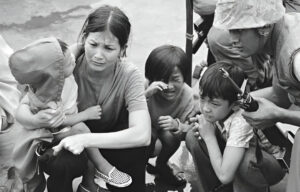 April 29, 1975:
April 29, 1975:
A South Vietnamese mother and her three children are shown on the deck of an amphibious command ship being plucked out of Saigon by US Marine helicopters
Photo Credit: AP
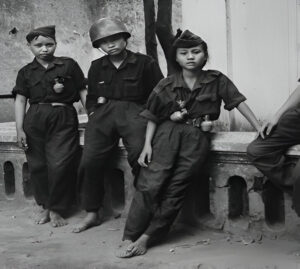 Young guerrillas wear grenades at their belts, preparing to fight the encroaching Viet Minh forces in the Red River Delta, northern Vietnam, 1954.
Young guerrillas wear grenades at their belts, preparing to fight the encroaching Viet Minh forces in the Red River Delta, northern Vietnam, 1954.
Photo: Howard Sochurek—The LIFE Picture Collection
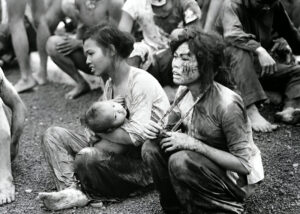
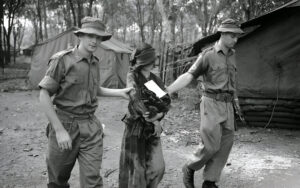 October 29, 1966. (AP)
October 29, 1966. (AP)
A Vietnamese girl, 23 years old, was captured by an Australian patrol 30 feet below ground at the end of a maze of tunnels some 10 miles west of the headquarters of the Australian task force (40 miles southeast of Saigon). The woman was crouched over a World War II radio set. About seven male Viet Cong took off when the Australians appeared—but the woman remained and appeared to be trying to conceal the radio set. She was taken back to the Australian headquarters where she told under sharp interrogation (which included a “waterprobe”; see her wet clothes after the interrogation) that she worked as a Viet Cong nurse in the village of Hoa Long and had been in the tunnel for 10 days. The Australians did not believe her because she seemed to lack any medical knowledge. They thought that she may have possibly been the leader of the political cell in Long Hoa. She was being led away after interrogation, clothes soaked from the “waterprobe” on AP.
 February 17, 1966. A Vietnamese child clings to his bound father who was rounded up as a suspected Viet Cong guerrilla during “Operation Eagle Claw” in the Bong Son area, 280 miles northeast of Saigon. The father was taken to an interrogation camp with other suspects rounded up by the U.S. 1st air cavalry division.
February 17, 1966. A Vietnamese child clings to his bound father who was rounded up as a suspected Viet Cong guerrilla during “Operation Eagle Claw” in the Bong Son area, 280 miles northeast of Saigon. The father was taken to an interrogation camp with other suspects rounded up by the U.S. 1st air cavalry division.
Photo: Richard Merron, Henri Huet/AP
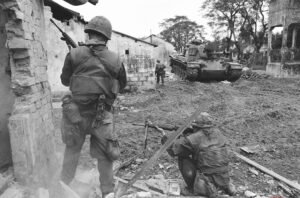
January 31, 1966.
A soldier, upper left, climbs from balcony to balcony while another, helmeted in center foreground, fires into a room during an effort to flush out Viet Cong fighters in a still-under construction hotel in Saigon near the South Vietnamese presidential palace. South Vietnamese and U.S. forces combined to halt an attack on the capital by the Cong guerrilla forces.
(AP Photo)
Command spokesman said 4,959 enemy were killed in action from 6 p.m. Monday to midnight Wednesday. Another 1,862 persons were seized as Viet Cong suspects. U.S. casualties for the period were listed as 232 killed and 929 wounded. South Vietnamese government casualties were 300 killed and 747 wounded, a spokesman said. Other allied casualties were put at three killed and 22 wounded. South Vietnamese authorities said 660 Viet Cong were killed in Saigon alone in less than two days of fighting. There was no immediate word on the number of civilian casualties in the capital or elsewhere across the nation, but they were believed to have been heavy.
******
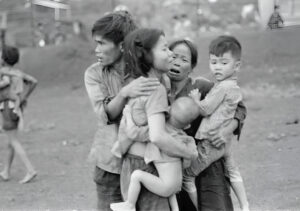 June 1965, “Déjà Vu”
June 1965, “Déjà Vu”
Photo: Horst Faas (AP)
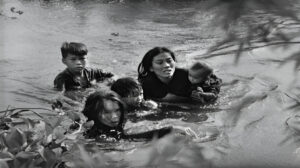 1965
1965
American Air Force came to Qui Nhon village, and ordered that all the women and children must vacate the village immediately.
Photo: Kyoichi Sawada, United Associated Press.
(1966 Pulitzer Prize).
******
Operation Rolling Thunder
Most barbaric example in human history.
Take an account: Korean war had 6,53,000 tonnes, the 2nd World War Pacific zone had 5,03,000 tonnes. But Operation Rolling Thunder had 8,64,000 tonnes. 1,53,000 times by the American Ar Force, and 1,52,399 times by their Navy. To note, America did more bombing on Vietnam compared to Germany in WW2.
Something to understand. The fighting countries in WW2 had their military strengths, the fight was between two strong opponents. It was not same in Vietnam war where world’s so called strongest power is attacking a country having no military power. were strong enough
American Army’s Commander in Chief, Pacific (CINCPAC), (CINCPAC OPLAN 37–64), “closed” 94 targets in March, 1964. The targets were bridges, naval port, railway, and food and supply distribution godwns, However, Vietnamese guerrilla leaders could sense the plan, and could make some defensive plans. “… complete destruction of the entire country, including Hanoi and Haiphong. The communist leadership declared “a people’s war against the air war of destruction…each citizen is a soldier, each village, street, and plant a fortress on the anti-American battlefront.” All except those deemed “truly indispensable to the life of the capital” were evacuated to the countryside. By 1967, Hanoi’s population had been reduced by half.”
Though USSR and China supplied a lot of arms, but did not help in the war front as it could have sparked another World War and that’s what America was looking for as an escape route. Though at one point of time, the guerrilla units had enough arms from USSR and China, but they were not trained. Before Operation Rollling Thunder, they had about 1,500 light 37 and 57mm anti aircraft machines. Within one year the number rose to 5,000 and also 85 and 100 mm radar directed machines. The number increased to 7,000 by 1967. America had no idea how they are getting the arms, resulting 80% loss of American air planes.
On 19 May, Rober McNamara wrote to American president: There may be a limit beyond which many Americans and much of the world will not permit the United States to go. The picture of the world’s greatest superpower killing or seriously injuring 1,000 non-combatants a week, while trying to pound a tiny, backward nation into submission on an issue whose merits are hotly disputed, is not a pretty one.
*******
Operation Bloodhound
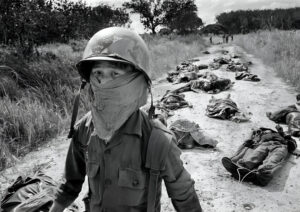 27 November 1965.
27 November 1965.
In the guerrilla war with Viet Cong (VC) 271st and 273rd Regiments, about 500 American army men were killed. On Vietnamese side, the number was about 100. More than 100 bodies were recovered after the Vietcong overran South Vietnam’s 7th Regiment, 5th Division, killing most of the regiment and several US advisers.
A South Vietnamese stretcher-bearer wears a face mask to protect himself from the smell as he passes the bodies of US and South Vietnamese soldiers killed fighting the Vietcong in the Michelin rubber plantation (72 km North West from Saigon). The plantation, situated midway between Saigon and the Cambodian border, was the scene of frequent fighting throughout the war.
Photograph: Horst Faas/AP
Then America launched Operation Bloodhound (1-6 December 1965), which was later renamed as Operation Bushmaster II, with major air attacks.
*******
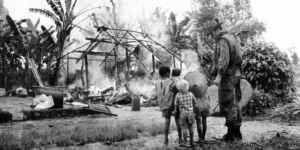
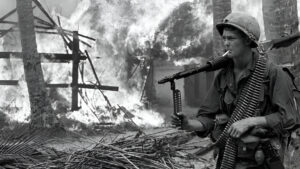
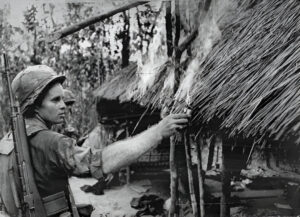 November 15, 1965: a US Army officer sets fire to a hut in a Viet Cong training camp captured by the First Infantry Division during an attack on a stronghold 50 miles north west of Saigon Credit: AP
November 15, 1965: a US Army officer sets fire to a hut in a Viet Cong training camp captured by the First Infantry Division during an attack on a stronghold 50 miles north west of Saigon Credit: AP
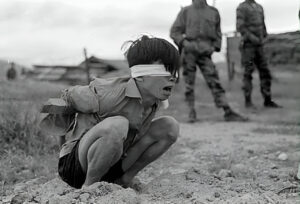
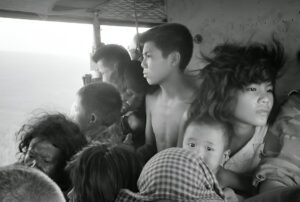 Vietnamese and Cambodian refugees crowd a U.S. helicopter which evacuated them from immediate combat zone of the U.S.-Vietnamese incursion into Cambodia on May 5, 1970. They were taken to a refugee reception center at the Katum Special Forces camp in South Vietnam, six miles from the Cambodian border. (Ryan/AP)
Vietnamese and Cambodian refugees crowd a U.S. helicopter which evacuated them from immediate combat zone of the U.S.-Vietnamese incursion into Cambodia on May 5, 1970. They were taken to a refugee reception center at the Katum Special Forces camp in South Vietnam, six miles from the Cambodian border. (Ryan/AP)
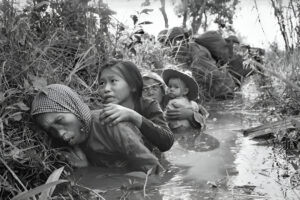 1 January 1966
1 January 1966
Women and children crouch in a muddy canal as they take cover from intense Vietcong fire.. Paratroopers of the 173rd Airborne Brigade (background) escorted the civilians through a series of firefights during the US assault on a Vietcong stronghold at Bao Trai, about 20 miles west of Saigon
Photograph: Horst Faas/AP
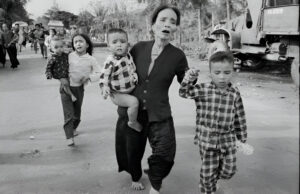

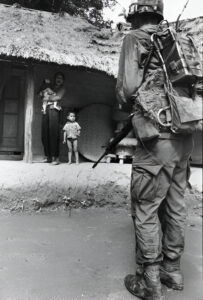
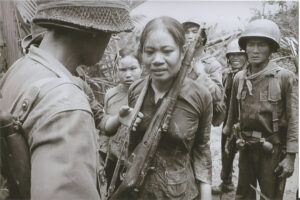 25t August 1965
25t August 1965
Photo: Associated Press.
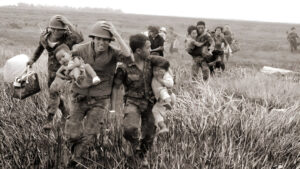
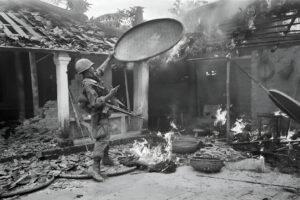 27 October 1967
27 October 1967
American army torched the entire Tam Ky village (350km from Saigon) and then throws the home groceries on the fire.
Photo: Dang Van Phuoc (AP).
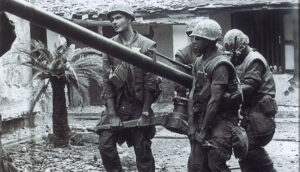
Bob Wallace (far left) and others carrying a 400-pound 106mm recoilless rifle through the streets of Huê´, Vietnam, during the Tet Offensive in 1968.
Photo courtesy of Bob Wallace
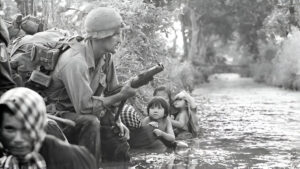 South Vietnamese children gaze at an American paratrooper as they cling to their mothers, hiding from Viet Cong sniper fire west of Saigon, January 1966.
South Vietnamese children gaze at an American paratrooper as they cling to their mothers, hiding from Viet Cong sniper fire west of Saigon, January 1966.
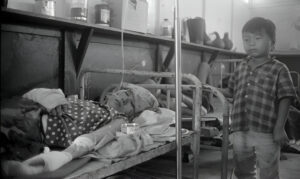 20 April 1970
20 April 1970
Mother is wounded in American air attack, under treatment at Vo Thi Phuong hospital. The helpless child is just onthe bedside.
Photo: Don Hirst/Overseas Weekly Collection/Hoover Institution Library and Archives
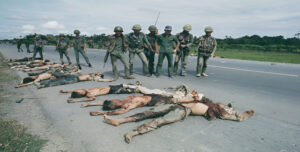 19 August, 1972
19 August, 1972
Common civilians killed by American soldiers at broad daylight of Cai Be district.
Photo: Rolls Press (Getty Images)
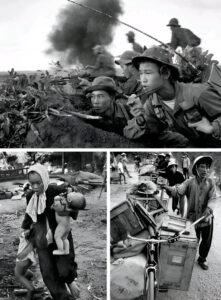
 The bodies of some of the seven blindfolded people executed by the Viet Cong lie near gas pumps in the Cholon section of Saigon during the Tet Offensive on Feb. 9, 1968. The area had not yet been secured to recover the bodies.
The bodies of some of the seven blindfolded people executed by the Viet Cong lie near gas pumps in the Cholon section of Saigon during the Tet Offensive on Feb. 9, 1968. The area had not yet been secured to recover the bodies.
AP Photo/Eddie Adams
February 2, 1968
Widespread, savage fighting ranged into the fifth day in key South Vietnamese cities Saturday.
The U.S. Command reported 12,704 enemy had been killed since Monday evening in allied counterattacks that were said to be crushing the biggest Communist offensive of the war.
Fresh fighting broke out in parts of Saigon, and masses of civilians were reported fleeing a battle in a northern suburb of the capital.
By Edwin Q. White, (AP, Saigon)
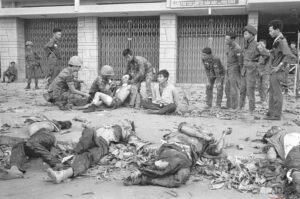
The U.S. Command said enemy fighters were killed at a rate of 124-plus per hour during the 102-hour period from 6 p.m. last Monday through Friday midnight, making the total 12,704. Allied forces also reported they detained 3,576 enemy suspects.
A total 983 allied troops were killed in the 102-hour period, including 318 Americans and 661 South Vietnamese. Allied wounded totaled 3,483, of whom 1,639 were Americans and 1,792 South Vietnamese.
While the Communists held parts of several cities and towns across the country, President Nguyen Van Thieu declared:
“The back of the Viet Cong attack has been broken. We can consider they have been totally defeated.”
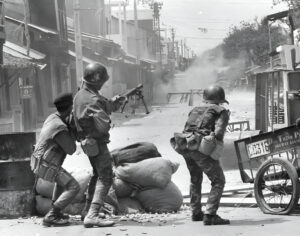
The Mỹ Lai Massacre
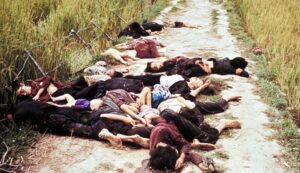 Photo: Ronald L. Haeberle
Photo: Ronald L. Haeberle
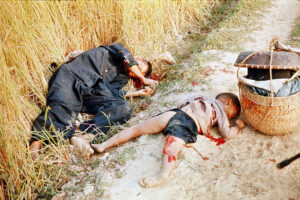
“I was ordered to go in there and destroy the enemy. […] That was my job on that day. That was the mission I was given. I did not sit down and think in terms of men, women and children.”
– Lieutenant William Calley, testifying at Court-Martial in defense of his actions.
March 16, 1968,
US Army massacred 504 civilian villagers, including women, children and old men. The American general William Westmoreland congratulated these men for “exceptional action” and for “bringing a heavy blow to the enemy”.
The orders were given to kill people, burn houses, kill livestock, destroy foodstuffs and plug wells. Army began to attack everything that moved, humans or animals, with grenades and machine guns, assisted by combat helicopters.
It was a real carnage, killing unarmed common men, women, children and babies. Women were raped when some victims were mutilated with the “C Company” signature carved on their chest before being shot. After this tragedy:
50 victims were 0 to 3 years old
69 victims were between 4 and 7 years old
91 victims were 8 to 12 years old
27 were over 70 years old
According to US military intelligence, a Viet Cong unit was operating in the area of Quang Ngai province and routed to My Lai, a hamlet in Son My village. On the morning of March 16, 1968, at approximately 7:30 am, an infantry company, under Lieutenant William Calley, was dropped off by helicopter and entered My Lai. The American soldiers completely closed the village but did not find a single fighter while the villagers, who were preparing to go to market, did not panic nor flee.
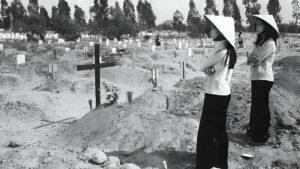
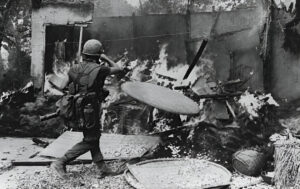
Following the Mỹ Lai massacre, court trial began. Lieutenant-General William Peers issued his report in March 1970 that 28 officers were accused of killings. In the end, Lieutenant Calley was found to be the only convict. Sentenced to life in prison on March 29, 1971, but President Nixon intervened and Lieutenant Calley was finally placed under house arrest for three and a half years at Fort Benning and released by the Secretary of the Army.
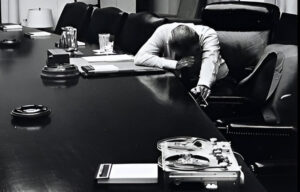 American President Lindon Johnson, at his White House office is listening the recorded tape of his son-in-law Charles Rob who was a U.S. Marine Corps commander.
American President Lindon Johnson, at his White House office is listening the recorded tape of his son-in-law Charles Rob who was a U.S. Marine Corps commander.
Photo: Jack Kightlinger/AP via Atlantic In Focus.
*******
Burnt Girl in an Aerial Napalm Attack
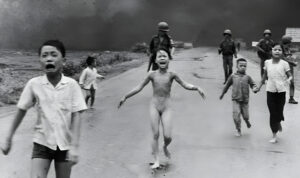 8 June 1972.
8 June 1972.
Nine-year-old Kim Phuc had ripped off her burning clothes while fleeing.
Severely burned in an aerial napalm attack, children run screaming for help down Route 1 near Trang Bang, followed by soldiers of the South Vietnamese army’s 25th Division. A South Vietnamese plane seeking Vietcong hiding places accidentally dropped its flaming napalm on civilians and government troops instead. America said, “… accidentally dropped its flaming napalm on civilians, outside the village of Trang Bang. Tragically, the group crowd was mistaken for the enemy.”
Photograph: Nick Ut/AP
This photograph “Napalm Girl” by Nick Ut received the 1973 Pulitzer prize for spot news photography
Phan Thi Kim Phuc later said “I turned my head and saw the airplanes, and I saw four bombs landing down. Then, suddenly, there was fire everywhere, and my clothes were burned up by the fire. At that moment I didn’t see anybody around me, just fire. I will never forget that moment, I still remember what I thought: Oh my goodness, I got burned, I will be ugly, and people will see me different way. But I was so terrified.”
Young Vietnamese photographer Nick Ut (then aged only 21) later shared in Los Angeles TV, “I saw Kim running and she screamed in Vietnamese ‘Too hot! Too hot!’” “I saw that her body was burned so badly, and I wanted to help her right away. I put all my camera gear down on the highway and put water on her body.” Nick Ut immediately took her in his office van and went to the hospital where he was told that free bed was not available. “I said, ‘If she goes one more hour (without treatment), she will die,” Nick Ut took out his press card, and conveyed to the doctors …. (he recalled his exact words to the hospital as: “If one of them dies you’ll be in trouble.”)
Nick Ut then rushed to his Saigon Associated Press office and distributed worldwide. “the skin of her back and arms scorched by the flammable jelly that made napalm such a controversial weapon.” “When I went back to my office, the (dark room technician) and everyone who saw the picture told me right away it was very powerful, and that the photo would win a Pulitzer.” And truly this photo won 1973 Pulitzer Prize for spot news photography.
In 1992, Kim Phuc migrated to Canada with diplomatic immigration and she felt inspired to use her personal tragedy for wider good. She made Kim Foundation International with apurpose to support victims of war. In 1997, she became the United Nations Goodwill Ambassador and shared her experience in different countries.
“Now I can look back and embrace it… I’m so thankful that (Ut) could record that moment of history and record the horror of war, which can change the whole world. And that moment changed my attitude and my belief that I can keep my dream alive to help others.”
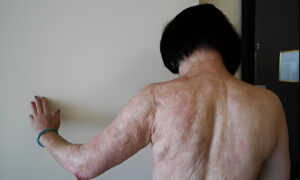
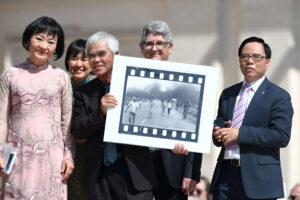
*******
Tet Offensive
Tet (Tết Nguyên Đán), the Vietnamese Lunar New Year, is the most important holiday in Vietnam, a time for family reunions, celebrations, and marking the beginning of spring. It’s a nationwide holiday, with businesses and factories typically closed for several days around the actual date. Tet is based on the lunar calendar and usually falls between late January and early February.
The crulty of American war reached to the extent that they decided to launch an offensive on the Tet Festival day, because Americans thought that the common Vietnamese people and also the guerrilla units would be in relaxed mood and not be so prepared for a fight.
The Tet Offensive of 30 January 1968 became one of the most shameful army operation in human history making a major launch on a festival day. (a major escalation and one of the largest military campaigns of the Vietnam War).
Probably America is the only country who could create such well planned voilence on another country’s soil.
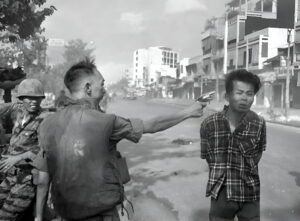 1 February 1968
1 February 1968
Gen Nguyen Ngoc Loan, South Vietnamese chief of the national police, suspects the man as guerrilla and fires his pistol into the head of Vietcong official Nguyen Van Lem on a broad daylight Saigon street early on in the Tet offensive day. Photographer Eddie Adams reported that after the shooting, Loan approached him and said: “They killed many of my people, and yours too,” then walked away. Later the photo was shown in American TV.
This photograph became famous as “decisive moment” and received the 1969 Pulitzer prize for spot news photography
Photograph: Eddie Adams/AP
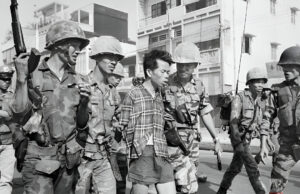
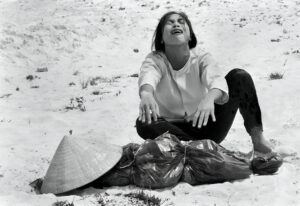 11 April 1969
11 April 1969
A woman mourns over the body of her husband after identifying him by his teeth and covering his head with her conical hat. The man’s body was found with 47 others in a mass grave near Hue. The victims were believed to be killed during the insurgent occupation of Hue as part of the Tet offensive
Photograph: Horst Faas/AP
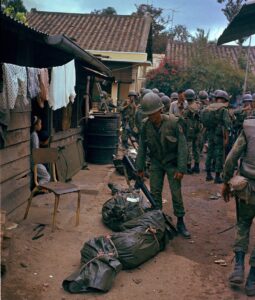
February 1, 1968.
The bodies of civilians and Viet Cong litter the street after bitter fighting in the early days of the Tet Offensive, in the northern section in Saigon, South Vietnam.
(AP Photo).
In the Chinese Cholon section of the capital, fighting broke out in front of a children’s hospital. Cholon was hit by six Viet Cong mortar shells during the night.
The allies reported killing more than 300 enemy in bitter fighting at Hue. The main gate of the citadel was wrested from Communist control. The U.S. Command said the enemy withdrew into the northern part of the old walled areas under repeated strafing and rocket raids by allied fighter-bombers. Among the targets of the allied planes were anti-aircraft guns the Communists had mounted on the towers of the citadel’s outer wall.
A report from President Johnson said 16 American planes and 23 helicopters were destroyed and about 100 other planes so severely damaged that they would have to be replaced. The average cost of American warplanes is estimated at $2 million.
Nearly 150 U.S. Marines were killed in the Battle of Hue, along with some 400 South Vietnamese troops. On the North Vietnamese side, an estimated 5,000 soldiers were killed, most of them hit by American air and artillery strikes. “What I saw was probably the most intense ground fighting on a sustained basis over several days of any other period during the war,” Howard Prince, a U.S. Army captain, later told NPR. “We didn’t know where the enemy was, in which direction even,” Mike Downs, a Marine captain, told NPR.
Despite its heavy casualty toll, and its failure to inspire widespread rebellion among the South Vietnamese, the the Americans thought Tet Offensive to be a strategic success for
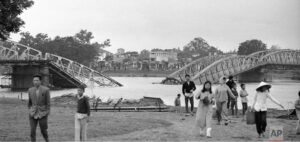
February 6 1968.
The main bridge across the Perfume River, connecting two parts of Hue, was blown up by Viet Cong,. The ancient Vietnamese imperial city is 50 miles south of he demilitarized zone in South Vietnam.
AP Photo/Rick Merron.
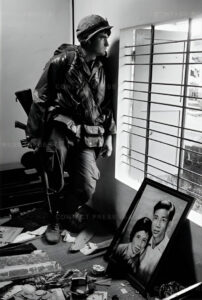
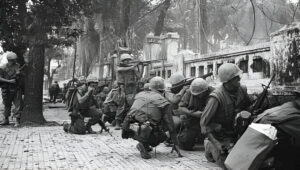
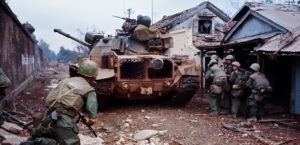
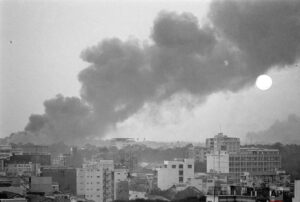
February. 8 1968.
Smoke rises over battle-scarred Saigon during the Tet Offensive as the sun sets over the South Vietnamese capital. Savage fighting was continuing there for the ninth consecutive day with Viet Cong guerrillas pitted against combined South Vietnamese and U.S. forces.
AP Photo/Eddie Adams.

February 19 1968.
A South Vietnamese soldier fires a machine gun into burning buildings in northeastern Saigon, Vietnam, where Viet Cong forces occupied several city blocks during the Tet Offensive. Early on the morning of Jan. 31, 1968, as Vietnamese celebrated the Lunar New Year, or Tet as it is known locally, Communist forces launched a wave of coordinated surprise attacks across South Vietnam. The campaign, one of the largest of the Vietnam War, led to intense fighting and heavy casualties in cities and towns across the South. Photo: Dang Van Phuoc (AP Photo)
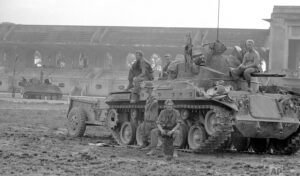
February 8-26, 1968.
US soldiers rest on top of a tank at the Phu Tho racetrack in western Saigon. US and South Vietnamese troops set up a fire support base at the track to support troops engaged in mop-up operations throughout the city during the Tet Offensive.
Photo: Eddie Adams (AP Photo)
While battles raged for more than a month in some places like the city of Hue, the Tet Offensive was from a strictly military standpoint a defeat for the North Vietnamese and Viet Cong forces. Yet the campaign had a profound impact on the U.S. war effort, stunning leaders in Washington and leaving the American public questioning their country’s involvement in the overseas campaign.
******
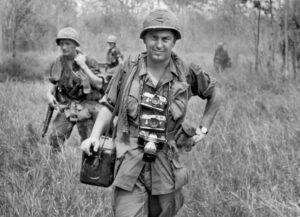
AP photographer Horst Faas, with his cameras around his neck, accompanies US troops in war zone C
Photograph: AP
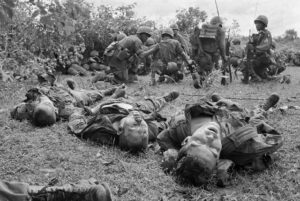 18 September 1965.
18 September 1965.
Bodies of US paratroopers lie near a command post during the battle of An Ninh. The paratroopers, of the 1st Brigade, 101st Airborne Division, were hit by heavy fire from guerrillas that began as soon as the first elements of the unit landed. The dead and wounded were later evacuated to An Khe, where the 101st was based. The battle was one of the first of the war between major units of US forces and the Vietcong
Photograph: Henri Huet/AP
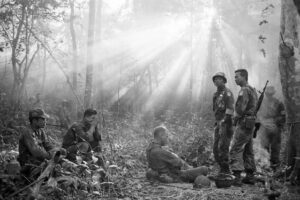 January 1965.
January 1965.
Sunlight breaks through dense foliage around the town of Binh Gia as South Vietnamese troops, joined by US advisers, rest after a tense night of waiting in an ambush position for a Vietcong attack that did not come.
Photograph: Horst Faas/AP
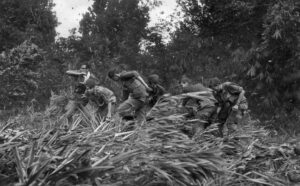 4 May 1970.
4 May 1970.
Life magazine photographer Larry Burrows (far left) struggles through elephant grass and the rotor wash of an American evacuation helicopter as he helps GIs carry a wounded soldier on a stretcher from the jungle to the chopper in Mimot, Cambodia. The evacuation came during the US incursion into Cambodia.
Burrows was killed on 10 February 1971, along with the photographer who took this picture, Henri Huet, and two other photojournalists – Kent Potter of UPI and Keisaburo Shimamoto of Newsweek – when their helicopter was shot down over Laos
Photograph: Henri Huet/AP
 19 May 1969.
19 May 1969.
A US paratrooper, wounded in the battle for Hamburger Hill, grimaces in pain as he awaits medical evacuation at base camp near the Laotian border.
Photograph: Hugh Van Es/AP
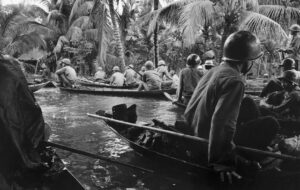 10 January 1966.
10 January 1966.
Caught in a sudden monsoon rain, part of a company of about 130 South Vietnamese soldiers moves downriver in sampans during a dawn attack on a Vietcong camp. Several guerrillas were reported killed or wounded in the action 13 miles northeast of Can Tho, in the flooded Mekong Delta
Photograph: Henri Huet/AP
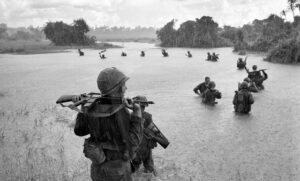 25 September 1965.
25 September 1965.
US paratroopers of the 2nd Battalion, 173rd Airborne Brigade, hold their automatic weapons above water as they cross a river in the rain during a search for Vietcong positions in the jungle area of Ben Cat. The paratroopers had been combing the area for 12 days with no enemy contact
Photograph: Henri Huet/AP
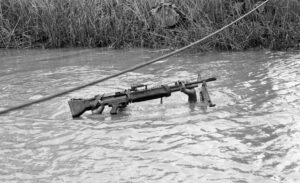 10 September 1968.
10 September 1968.
A 6ft 5in machine gunner with the US 9th Infantry Division is submerged except for his rifle as he crosses a muddy stream in the Mekong delta south of Saigon.
Photograph: Henri Huet/AP
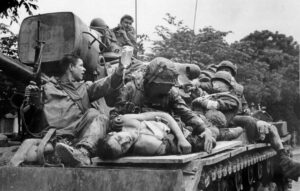 Marines transport their seriously wounded atop a US army tank through the streets of Hue toward a helicopter evacuation point on 17 February 1968. Tanks were the only vehicles able to travel the streets because of rubble from buildings destroyed during the still-ongoing Tet offensive. The marines came under sniper fire several times on the journey
Marines transport their seriously wounded atop a US army tank through the streets of Hue toward a helicopter evacuation point on 17 February 1968. Tanks were the only vehicles able to travel the streets because of rubble from buildings destroyed during the still-ongoing Tet offensive. The marines came under sniper fire several times on the journey
Photograph: AP Archive
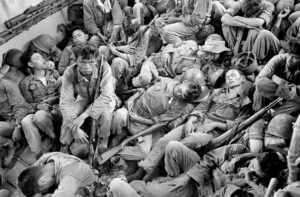 August 1962.
August 1962.
Exhausted South Vietnamese soldiers sleep on a US Navy troop carrier taking them back to the provincial capital of Ca Mau. The infantry unit had been on a four-day operation against the Vietcong in swamplands at the southern tip of the country
Photograph: Horst Faas/AP
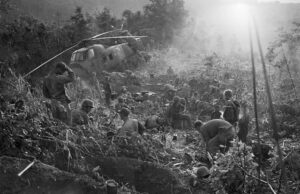 September 1966.
September 1966.
Marines emerge from their foxholes south of the DMZ after a third night of fighting against North Vietnamese troops.The helicopter on the left was shot down when it came in to resupply the unit
Photograph: Henri Huet/AP
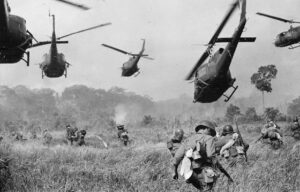 March 1965.
March 1965.
Hovering US Army helicopters pour machine-gun fire into the tree line to cover the advance of South Vietnamese ground troops as they attack a Vietcong camp 18 miles north of Tay Ninh, near the Cambodian border.
Photograph: Horst Faas/AP
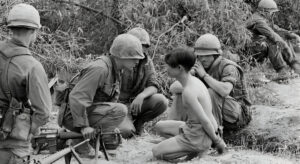 January 1968.
January 1968.
US Marines interrogate a prisoner during a search and destroy mission.
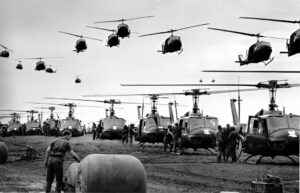 1966:
1966:
US Army helicopters providing support for ground troops fly into a staging area 50 miles northeast of Saigon.
Credit: AP Photo/Henri Huet
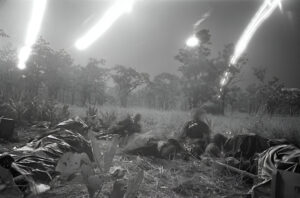 November 18, 1965,
November 18, 1965,
Flares from planes light a field covered with the dead and wounded of the ambushed battalion of the U.S. 1st Cavalry Division in the Ia Drang Valley, Vietnam, during a fierce battle that had been raging for days. Units of the division were battling to hold their lines against what was estimated to be a regiment of North Vietnamese soldiers. Bodies of the slain soldiers were carried to this clearing with their gear to await evacuation by helicopter.
Photo: Rick Merron/AP.
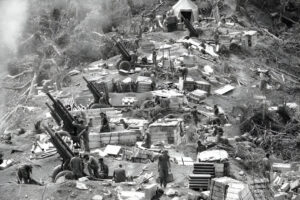 February 18, 1969.
February 18, 1969.
Marines prepare their 105-mm Howitzers for action at the end of a day in which this dense jungle area west of Hue was chopped down and molded into a fire-support base for a sweep of the area.
Photo: Dang Van Phuoc/AP.
 November 28, 1971.
November 28, 1971.
South Vietnamese troopers test fire flame throwers mounted atop APCs prior to moving out on operation west of Krek, Cambodia. Photo: Jacques Tonnaire/AP.
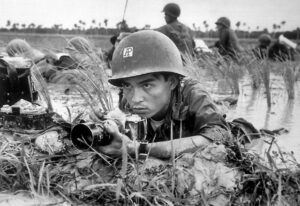 13 October 1965.
13 October 1965.
Photographer Huynh Thanh My, pinned down with a Vietnamese battalion in a Mekong Delta rice paddy, about a month before he was killed while covering combat. His younger brother, Nick Ut, later came to work for the AP as a photographer
Photograph: AP
********
The Kent State Massacre
In 1968, the Presidential candidate Republican Richard Nixon assured a peaceful diplomatic solution of Vietnam war. On 20 April 1970 he announced that 1,15,000 army men left Vietnam under withdraw programme. Further, he announced that another 1,50,000 army men would be withdrawn. However, on (date) he made a contradictory statement in the TV that “….. U.S. and South Vietnamese troops were mounting a major invasion of Cambodia which had provided a haven for the VietCong and North Vietnamese troops.” It became clear that the “Cambodian Incursion” had already been launched by United States combat forces before US President made this statement in the TV.
The next day, 1 May 1970 the Kent University Students assembled and announced their protest programme on 4 May 1970, “bring the war home.” Students of Black United Students (BUS) forum agreed to join. At the end of the day US president visited Pentagon where a lady said, “I loved your speech. It made me proud to be an American” and President Nixon replied, “Listen, the boys that are on the college campuses today are the luckiest people in the world, going to the greatest universities, and here they are burning up the books, storming around this issue. You name it. Get rid of the war there will be another one.”
Governor Rhoads said, “… they make definite plans of burning, destroying, and throwing rocks at police and at the National Guard and the Highway Patrol. … They’re worse than the brown shirts and the communist element…. well-trained, militant, revolutionary group that has ever assembled in America.”
University administration annouced the assembly to be iillegal, however more than 2,000 students assembled for a peaceful demonstration. …… protest began with the ringing of the campus’s iron Victory Bell (which had historically been used to signal victories in football games). American Guard Armed Force took up their strategic positions (weapons “locked and loaded” and affixed with bayonets). The strategy was if situation demands one Company C officer would make one blank fire. However, denying the strategy, Serjeant Myron Pryor fired first at 12:24 noon, and immediately some of the National Guard people fired on the students. John Kifner of Newyork Times reported, “…… it appeared to go on, as a solid volley, for perhaps a full minute or a little longer.”
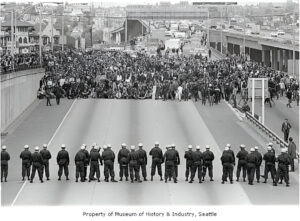
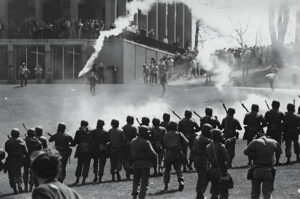
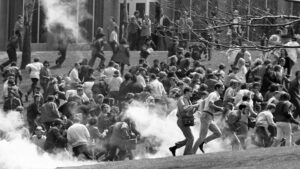
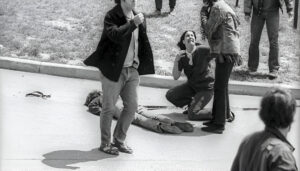
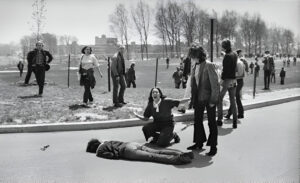 May 4, 1970.
May 4, 1970.
Fourteen-year-old Mary Ann Vecchio screams over the body of 20-year-old Kent State student Jeffrey Miller after he was shot by the Ohio National Guard during a protest against the U.S. invasion of Cambodia during the Vietnam War.
(Photo: John Paul Filo/Library of Congress
*******
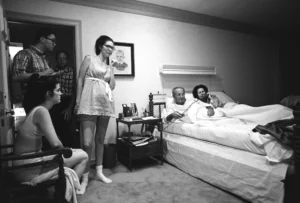 1968.
1968.
As tens of thousands of anti-war protestors rioted in Chicago during the 1968 Democratic National Convention, President Johnson and his family watched from the bedroom at his ranch in Stonewall, Texas.
Photo: Yoichi Okamoto—LBJ Library.
Pete Souza, former White House photographer for Presidents Reagan and Obama said, “….. This is truly an incredibly intimate picture. The caption provides pertinent information about the circumstance: the who, what and where. But I’m fascinated by the photograph because of the man behind the camera: Yoichi Okamoto. The first civilian hired as Chief White House Photographer, Okamoto also became the first one to truly document the Presidency for history. It’s obvious looking at this photograph that he had unfettered access to LBJ and that everyone was comfortable with him being in the room — even when the room was the President’s bedroom.
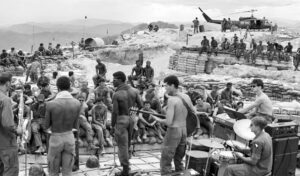 July 1970.
July 1970.
GIs of the 3rd Brigade, 101st Airborne Division, launch into a rock session while surrounded by symbols of the war: wooden bunkers, helicopter and sandbags. The soldiers were dug in at Firebase Kathryn on a hill south of the DMZ
Photograph: Giancarlo Meyer/AP
*******
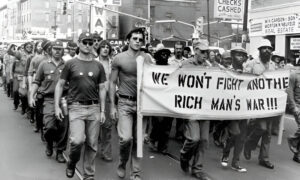
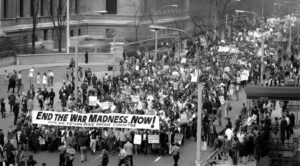 November 15, 1969
November 15, 1969
Millions of people across the United States take to the streets to protest the continued U.S. involvement in Vietnam. The antiwar demonstrations represent the largest public protests in U.S. history to date.
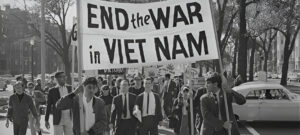 College students in Boston march against the Vietnam war, October 16, 1965. Courtesy of AP Photo/Frank C. Curtin.
College students in Boston march against the Vietnam war, October 16, 1965. Courtesy of AP Photo/Frank C. Curtin.
******
Why should they ask me to put on a uniform and go 10,000 miles from home and drop bombs and bullets on Brown people in Vietnam while so-called Negro people in Louisville are treated like dogs and denied simple human rights? No, I’m not going 10,000 miles from home to help murder and burn another poor nation simply to continue the domination of white slave masters of the darker people the world over. This is the day when such evils must come to an end. I have been warned that to take such a stand would cost me millions of dollars. But I have said it once and I will say it again. The real enemy of my people is here. I will not disgrace my religion, my people or myself by becoming a tool to enslave those who are fighting for their own justice, freedom and equality. If I thought the war was going to bring freedom and equality to 22 million of my people they wouldn’t have to draft me, I’d join tomorrow. I have nothing to lose by standing up for my beliefs. So I’ll go to jail, so what? We’ve been in jail for 400 years.
Muhammad Ali
Redemption Song: Muhammad Ali and the Spirit of the Sixties
There is at the outset a very obvious and almost facile connection between the war in Vietnam and the struggle I, and others, have been waging in America. A few years ago there was a shining moment in that struggle. It seemed as if there was a real promise of hope for the poor — both black and white — through the poverty program. There were experiments, hopes, new beginnings. Then came the buildup in Vietnam, and I watched this program broken and eviscerated, as if it were some idle political plaything of a society gone mad on war, and I knew that America would never invest the necessary funds or energies in rehabilitation of its poor so long as adventures like Vietnam continued to draw men and skills and money like some demonic destructive suction tube.
Martin Luther King, Jr.
at Riverside Church, New York City,
“A Time to Break Silence”, April 4, 1967
******
 1972, Soc Trang Province
1972, Soc Trang Province
Freedom fighter Lam Thi “Dep” (in Vietnam, “Dep” means beautiful)
Photo: Minh Truong. “You could find women like her almost everywhere during the war”, Minh Truong says. “She was only 24…” “She had tried to live an honest life, but the war had given her no choice. It had forced her to make up a version of herself which was acceptable to others. In a way, making up stories had been the basis of her survival and her success.”
― Nguyễn Phan Quế Mai, the author of Dust Child
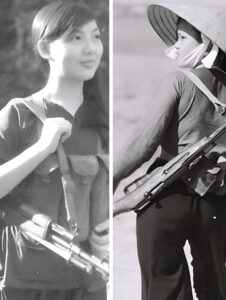
“The Vietnam War remains, then, studying the war is an intellectual undertaking and a valuable exercise in civic responsibility. According to estimate, more than 30,000 books have been published about the war, a number will no doubt grow to even more staggering heights as authors gain access to new sources, especially from repositories outside the United States, and open new lines of inquiry.”
******
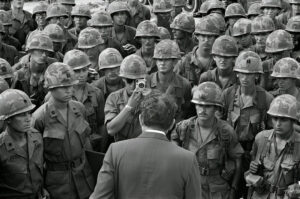 30 July 1969
30 July 1969
A GI gets a closeup photo as President Nixon meets with troops of the 1st Infantry Division at Di An, 12 miles northeast of Saigon, on his eighth visit to South Vietnam and his first as president.
Photo: Bob Daugherty/AP.
*******
 29 April 1975
29 April 1975
CIA Air America helicopter on the rooftop of Saigon President’s Palace, evacuating American nationals after their surrender.
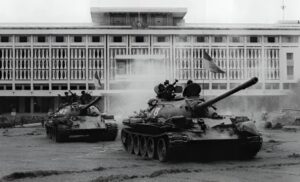 April 30, 1975.
April 30, 1975.
The previous day, on 29 April 1975 Commander General Văn Tiến Dũng attacked American’s allied force Republic of Vietnam (ARVN) Commander General Nguyễn Văn Toàn, ensuring later’s surrender. And on 30 April, at morning 10-45 hours, the voctorious tank bulldozed through the main gate of President’s Palace, and this marked the end and victory of Vietnam war.
At 11:30 a.m. local time the Vietcong flag was raised above it.
This victory was achieved after nearly one-and-a-half million people had been killed, and a further three million wounded.
Photo Credit: AP
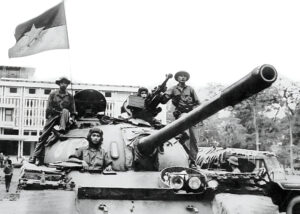
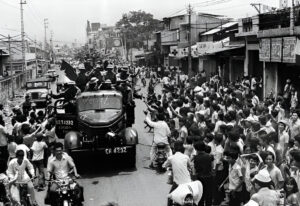
April 30, 1975: Saigon residents take to the street to welcome the arrival of communist troops on trucks after the fall of Saigon which marked the end of the Vietnam War Credit: AFP
*******************

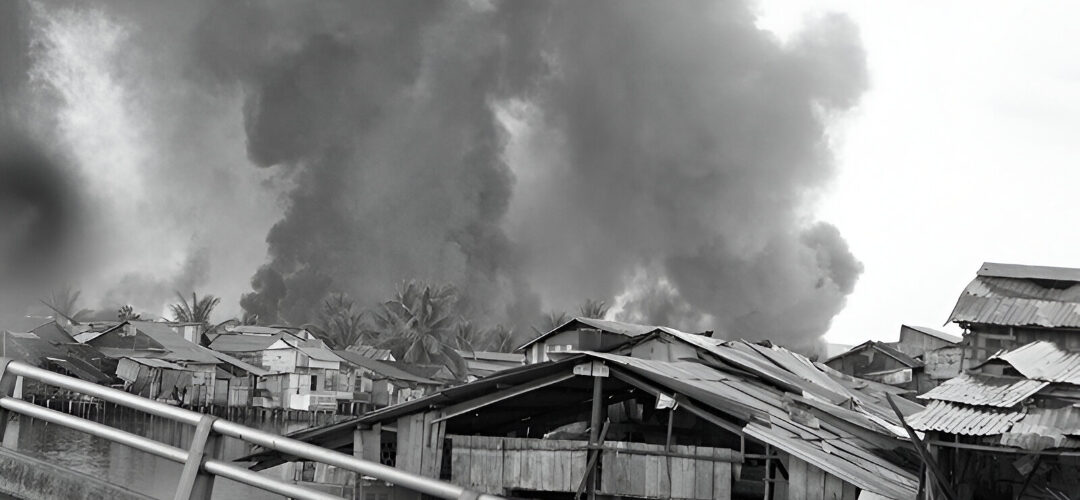
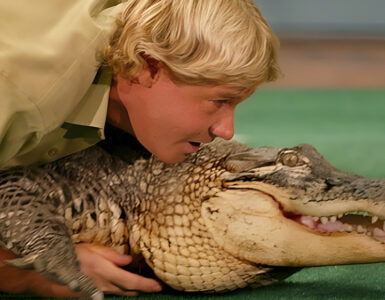
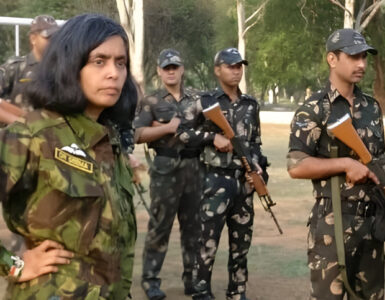
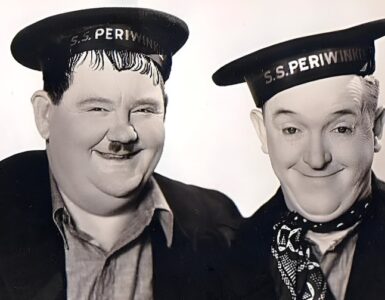









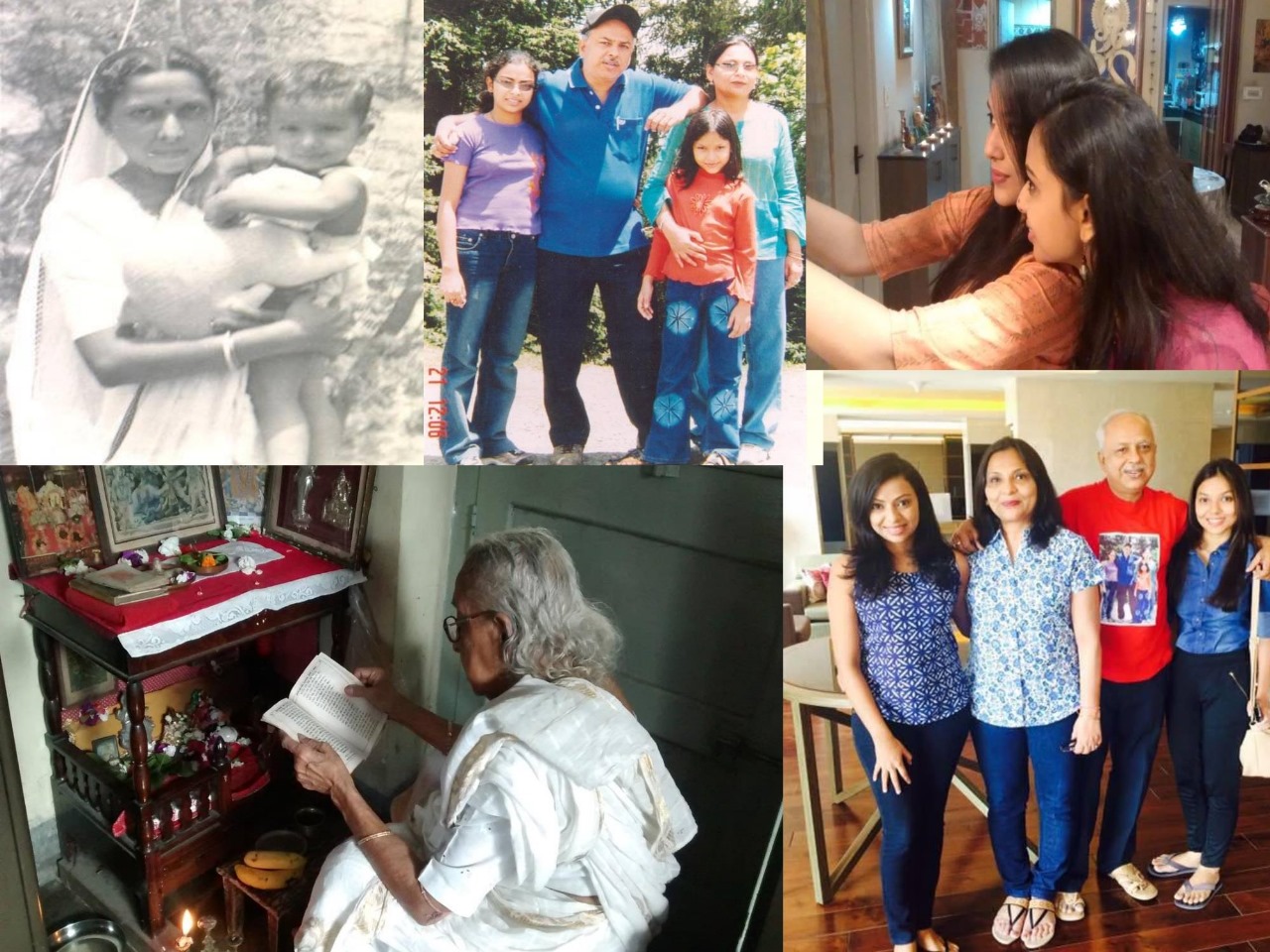
এতো তথ্য সমৃদ্ধ লেখা খুব একটা দেখা যায় না। শুধু ছবি গুলো দেখলেই বোঝা যাচ্ছে কি ভয়ঙ্কর এবং অমানুসিক অত্যাচার আমেরিকা ভিয়েটনামিস দের ওপরে করেছিলো। আমরা তখন স্কুলে পড়ি প্রায় রোজই নিউজ পেপারে এইসব ঘটনার কিছু বিবরণ পাওয়া যেতো। যাইহোক অসীম কে ধন্যবাদ এতো তথ্য সমৃদ্ধ লেখা আমাদের সামনে উপস্থাপিত করার জন্য। ❤
এতো তথ্য সমৃদ্ধ লেখা খুব একটা দেখা যায় না। শুধু ছবি গুলো দেখলেই বোঝা যাচ্ছে কি ভয়ঙ্কর এবং অমানুসিক অত্যাচার আমেরিকা ভিয়েটনামিস দের ওপরে করেছিলো। আমরা তখন স্কুলে পড়ি প্রায় রোজই নিউজ পেপারে এইসব ঘটনার কিছু বিবরণ পাওয়া যেতো। যাইহোক অসীম কে ধন্যবাদ এতো তথ্য সমৃদ্ধ লেখা আমাদের সামনে উপস্থাপিত করার জন্য। ❤
অসীমের লেখা ভালো করে পড়লাম। আমি ভিয়েতনামের লোকেদের অদম্য সাহস আর রুখে দাঁড়ানোর মানসিকতা নিয়ে অসীমের সাথে একমত যে, The people of Germany and Japan had to rebuild their nation, as they surrendered after the devastating end of the second World War in 1945 (on their part). In Vietnam too, people had to rebuild their nation, though devastated but not as a consequence of loss, rather that of a glorious victory as a result of their struggle for independence.
পরম শক্তিধর আমেরিকা একটি দুর্বল অনগ্রসর দেশের উপর শক্তি প্রদর্শন করতে চায়। দ্বিতীয় বিশ্বযুদ্ধে এক দেশ অন্য দেশের ঘরবাড়ি, ব্রিজ, নৌবন্দর উড়িয়ে দিয়েছে। ভিয়েতনামে অন্যরকম। সেখানে প্লেন থেকে naplam বোমা ফেলে মানুষকে জীবন্ত জ্বালিয়ে দেওয়া হয়েছে, প্লেন থেকে বিষাক্ত Agent Orange স্প্রে করে গ্রামে গ্রামে মানুষকে বিকলাঙ্গ করে দেওয়া হয়েছে, শস্য ক্ষেত্র নষ্ট করে দেওয়া হয়েছে, গ্রামে গ্রামে ঘরবাড়ি জ্বালিয়ে দিয়েছে, জলে বিষ মিশিয়ে দিয়েছে, নিরীহ মানুষদের গুলি করে মারা হয়েছে। আমরা স্কুল কলেজে ভিয়েতনাম শুনতাম, কিন্তু এর ভয়াবহ চেহারা “অচেনা ভিয়েতনাম” পড়ে এবং ছবিগুলো দেখে জানতে পারলাম।
I had been to Vietnam, and made a point to visit War Museum, and Cu Chi Tunnel. Have seen the horror pictures in the museum. Every American should make a visit to the war museum to understand what their ancestors did, how cruel and uncivilized they were.
Actual Vietnam history should be taught in American schools, not the history written by Kennedy, Johnson, Nixon, or McNamara.
Thanks author for your so much of hard work.
A country’s military is travelling 10s of thousands of miles to attack a tiny nation, destroying their corps which is their only living and economy, spraying gas to make innocent people physically disabled for ever, dropping fire bombs on civilian villagers …. a long list of horrors.
And how can a nation plan for military aggression, operation on the day of a festival?
Possible only by the Americans.
Shame America, shame.
Those soldiers can be called blood hungry wild jackel with firearms and poisons. They are the gang of rapists.
America is a nation that proved how innocent people can be massacred.
অনেক অজানা তথ্য তুলে ধরেছেন । বলিষ্ঠভাবে সভ্যতার এক অন্ধকার অধ্যায়কে সাজিয়ে সাবলীলভাবে পরিবেশন করলেন অসীম বাবু।
One of the most shameful chapter in the world history. America making a base in another country means only massacre and destruction.
I would say, every American schools must teach Vietnam history to their students. Let them know about their pride civilisation.
Exhaustive and a thorough compilation of Vietnam war. The photographs along with the narration is so interesting and that much more scary and pathetic, where one could understand the plight of common Vietnam citizens and the horror of the war from the photographs. Truly a historic document. Will be interested to know the name of the herbicide molecule Agent Orange used by US troops as a biological weapon.
What a collection!
These hundred photographs take us back to sixties and seventies of the last century.
The carpet bombing of paddy fields and hamlets of Vietnam.
Napalm bombs making the air a raging flame!
My Lai massacre!
The conscience of whole world was troubled.
Students on the roads in America, in Paris, in Bonn, in London.
Buddhist monks embressing self-immolation.
Ninety year plus Bertrand Russell organising an international war tribunal putting US war machine at dock , accusing them of comnitting crime against humanity.
All has become vivid, thanks to this revetting collection.
No praise is good enough for the creator of this living history.
আমি তোর সাইটটা আমার গ্রুপে পোস্ট করে নিয়েছি পরে দেখবার এবং আলোচনা করার জন্য।
একটা দারুন লেখা আর ছবির সংকলন, উদ্দীপিত হয়ে গেলাম।
তুই চালিয়ে যা, আর পারলে আমায় একটা জানান দিস, পড়তে তো পারবো।
👍
The world’s most cruel most power hungry nation marked their shameful retreat in golden words in the history. I agree, every American kid should study uncensored history of Vietnam War, compulsory at schools.
সবরকম রাজনৈতিক মতবাদের উর্দ্ধে গিয়ে বলছি, যে ভিয়েতনামের লোকজন এক অসম যুদ্ধ লড়ে গেছেন, তাঁদের লাল সেলাম না জানিয়ে উপায় নেই।
আমার এই সেলাম কিন্তু রাজনীতির সংকীর্ণতার ঊর্ধ্বে।
Before going through the contents and photos, I had the idea about the cruelty of Vietnam aggression. But I never thought it was to such an extent.
You need not read any book of history, just these 100 photos would give you the horrible picture of American cruelty.
The most power hungry nation got the right treatment in the hands of a group of poor backward class of people. I could have used much harsh words for the Americans, but restrained.
Tremendous research and commendable effort on part of Asim Deb in collecting and collating such a volume of heart wrenching information and pictures .
War is always a last option for any nation to resolve political or territorial issues. Use of Chemical weapons and killing of civilians in a barbaric manner is violative of Geneva conventions and is inhuman. America is known for fighting wars far away from its own land and hence doesn’t realise the horrific effects it has … a disturbing trend .
Thanks Brig. Maini
So nice of you for your reading and encouraging words.